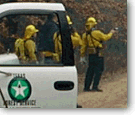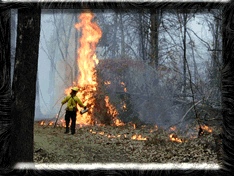Did I say "including?" Yes, you read it correctly, the U.S. Forest Service set fire to our property. It was not without our permission and participation that they did so. Don and I had been reading a little here and there about prescribed burns and how they help to manage and restore grasslands and forests. Our 30 acres could definitely benefit from land conservation and restoration techniques such as burning. So when the Forest Service asked us if they could cut across the back of our property to prepare for a burn this spring, we were more than happy to ablidge.
Preparation for the burn began late last summer with the creation of "fire cuts" by the park employees. These "fire cuts" or "fire breaks" are nothing more than a six to eight foot wide, cleared trail thru the forest which mark the boundaries of the controlled burn. Sometime last August we met Joel Shepard who works for the Forest Service at the Caddo National Grasslands unit. He asked us if we would mind if they made a fire break across the middle of our property for the burn they were planning this Spring. We enthusiastically agreed to participate. The fire cut near us parallels our fence line to the point it cuts across our property. This was a definite benefit to us in and of itself, since we hadn't begun cutting a trail to the back of our property, and we now have better access to our fence for maintanence tasks and marking our property line with "No Trespass" signs.
We got another visit from Joel sometime in January, letting us know that they still planned to burn this Spring, probably in early February. (Well, that's Spring for Texas anyway.) The weekend before the burn, they did more clearing of the fire breaks. They used leaf blowers and chainsaws to make the fire breaks completely clear of any leaves, branches, small trees, etc. that could burn. In this way, the fire breaks not only serve to mark the boundary of which acres to burn, but they also manage the fire, keeping it from spreading to unwanted areas.

In the two days preceding the burn and the day on which the burn was scheduled, we met lots of people from the Forest Service and private contractors who were doing the burn. They wanted to make sure we knew what was going on, where they would be, and when. On the morning of February 4th, a Forest Service truck loaded with firemen pulled up to our property line. They had special equipment for the burn, including torches, special guns, and an ATV with a built in torch. They began making there way down our fence line and thru the acres to the west of us leaving behind little trails of fire. With the special fuels they were using, they were able to make low heat fires that only burned the top layer of leaves, grasses, forest debris, dead wood, and some of the smaller cedars and junipers. This accomplishes two things. First, it burns up the more combustible forest materials that can lead to potentially harmful forest fires in periods of drought. Second, it cuts down on some of the unwanted cedar and juniper trees, which, left unmanaged can lead to other problems such as decreasing the water table of an area due to their high absorbtion and water shedding characteristics. What forest fires once kept in check naturally, these controlled burns are attempting to recreate.
 The burn lasted from morning to evening. In that time, the Forest Service planned to burn approximately 1,500 acres. I don't think they got to meet their goal this time, however, because the conditions were not quite right for them to drop their igniting ping pong balls from their helicopter. The ping pong balls are supposed to go thru a chemical reaction and the burst into flames. Unfortunately, conditions were to humid and damp for the balls to ignite. It's too bad, I was really looking forward to watching the fireballs in action.
The burn lasted from morning to evening. In that time, the Forest Service planned to burn approximately 1,500 acres. I don't think they got to meet their goal this time, however, because the conditions were not quite right for them to drop their igniting ping pong balls from their helicopter. The ping pong balls are supposed to go thru a chemical reaction and the burst into flames. Unfortunately, conditions were to humid and damp for the balls to ignite. It's too bad, I was really looking forward to watching the fireballs in action.
When it started getting dark and the decision was made to relinquish the helicopter, Joel and the others went back down the fire cuts on tractors, checking that the fire was still under control and there were no potential hazards. We were given a number we could call if we noticed any out of control fire. The fire actually smoldered for several days after the burn until the first heavy rain. The smoke and haze cleared about 2 days after the burn.
So that is a brief summary of our experiences with controlled burning and working with the U.S. Forest Service in the areas of land management and conservation. We had a great time and learned a lot. I hope we will get the opportunity to do it again.
